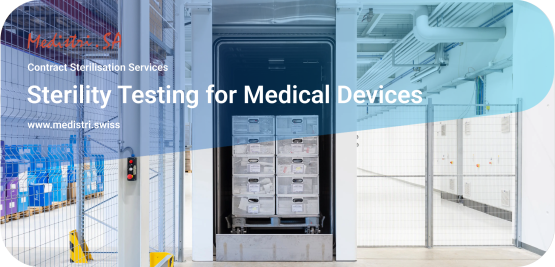(Download: Sterility Testing for Medical Devices in PDF by Medistri)
The evaluation of sterility on medical devices, manufacturers are required to perform the validation of the sterilization process according to different standards, such as ISO 11137.
Manufacturers of sterile medical devices must demonstrate the microbiological safety of their products through the following processes:
👉 Knowledge regarding the device’s bioburden
👉 Validation of the sterilization process. An effective sterilization process has a very low Sterility Assurance Level (SAL), meaning that there is an extremely small likelihood (10- 6) of any infecting microbes surviving the sterilization process. SAL expresses the probability of a single item in a batch being non-sterile after being subjected to a sterilization process.
👉 Demonstrating sterility of the products manufactured (each released batch)
👉 Guaranteeing the sterility assurance during the shelf life of the product.
Reliable sterility testing and the development or validation of product-specific methods are critical steps in the development process. Sterility testing is required to ensure viable contaminating microorganisms are not evident in a product. This testing is conducted by direct inoculation or membrane filtration methods and is performed in a cleanroom environment.
Medistri provides Sterility Testing the pharmaceutical, biotechnology, medical devices and consumer products industries. Sterility testing is required during the sterilisation validation process as well as for routine release testing.
The three methods of Sterility Testing are:
✅ Membrane filtration
✅ Direct Transfer (Product Immersion)
✅ Product Flush.
The preferred method is direct inoculation of culture media. The routine sterility test at Medistri SA is performed in a clean room (ISO 7) under
laminar flow.
How Sterility Testing at Medistri’s In-House Laboratory is performed:
• Test Preparation
• Filter Prewetting
• Sample Filtration
• Rinsing
• Culture Media Filling
• Incubation Time
• Final Test Results
Sterility testing must be performed on any product intended to be sterile, such as large or small-volume parenteral, ophthalmic, non-injectable preparations, antibiotics, oils, emulsions, medical devices and more.
The United States Pharmacopoeia (USP) and European Pharmacopoeia (EP) both require specific articles and substances to be sterile. Surfaces are considered sterile if the possibility that it has been contaminated by viable microorganism is equal or less than one in a million. Sterility tests are performed through direct inoculation sterility testing, or through membrane filtration sterility testing.
Medistri SA has accreditation STS 504 for this analysis, both in routine testing and in validation (detection and deactivation of interference and growth inhibitors). Our procedures meet the requirements of appropriate and current versions of European and United States pharmacopeia and ISO standards.
🎯 To learn more about our Sterility Testing for Pharmaceuticals Services, visit on our website at www.medistri.swiss/enor directly contact our team at contact@medistri.swiss.
- The Medistri Team
#Medistri
